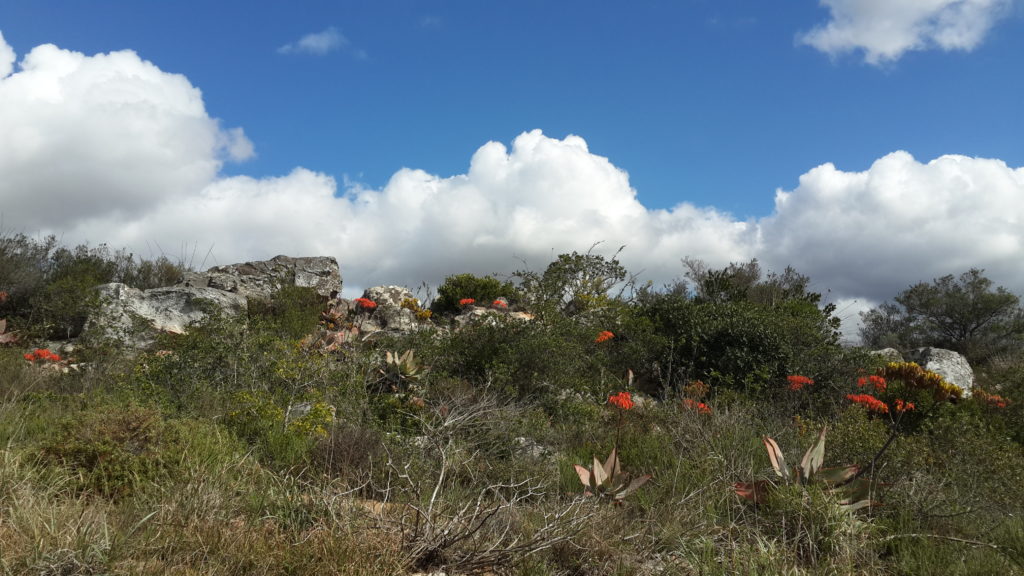 This month, Someleze Mgcuwa talks about Ummemezi (Cassipourea flanaganii)
This month, Someleze Mgcuwa talks about Ummemezi (Cassipourea flanaganii)
Brief history of imbola (ochre)
According to the history of cosmetic spans at least 6000 years and in almost every society on Earth.
Archaeologist evidence of cosmetics certainly dates from ancient Egypt and Greece. In Africa engraved
ochre (imbola) pieces from c. 75,000 years old levels were discovered at Blombos Cave in the Western
Cape. Imbola is used as a sacred ointment by amaXhosa, amaHlubi, amaNdebele, Basotho, Maasai,
Himba and many other Africans to this day. Xhosa people used iimbola (plural) for beauty, health,
wellbeing and as well as social status. Traditional cosmetics like Inongwe (Africana potato) Isibindi
(Ganoderma sp.) Umavumbuka and Ummemezi (Cassipourea flanaganii) are used by amaXhosa.
Although face primer, concealer, foundation, blush etc. are popular make-up tools among the
millennials and contennials generations, ummemezi is still one of the popularly used traditional cosmetic
both by men and women.
Is skin bleaching new to South Africa?
Historical records show that Xhosa women once made use of tambokie grass, a general name for several
tough species of grass such as Cymbopogon, Hyparrhenia and Miscanthidium, as bleaching agent. The
desirability of lighter skin was reinforced during the years of apartheid in South Africa, when dark skin
was linked to racial inferiority and lighter skin tones often made it easier to find favour. Light brown
shoe polish, lavender floor polish, snowhite (bottled cosmetic powder) etc. were the popular make-up
cosmetics according to my mother. Having a lighter skin was a big thing during the apartheid era. Being
light skinned was a measure of beauty by the cosmetic brands.
“Successful people used Ambi…The best skin lightening cream in the world.” one of the advertisements by Ambi back in the day. The chemical skin lightening industry in South Africa in the mid-1970s, was worth R12.8 million per annum.
Tsi! Amemeza AmaXhosa afuman’ uMmemezi (Xhosas called aloud, they have found the Onionwood)
“Ukumemeza” in Xhosa language, it means “to call aloud” to attract attention”. This expression also
lends its meaning to a small tree and popular skin cosmetic made its powder bark. The back is powered
by rubbing it on a rough stone and mixed with a little water to make a light brown paste that is applied
to the face with a forefinger. Many women including men used it to hide skin blemishes and treat
pimples, and long-term use improves the complexion and lightens skin tone. A medicinal harvester,
stated that ummemezi can be also used as a charm. Reasons for the use of onionwood to get a lighter
skin tone, to look younger and beautiful, wanting to be favoured by an employer, to attract of
boyfriends/girlfriends and to be lucky and more confident.
Ummemezi was only documented for the first time in the mid-1970s. Its popularity increased
dramatically after 1990, when new laws restricted mercury-based, commercial lightning products, which
could serious damage to the skin. The growing trade in traditional preparations based on plants such as
ummemezi (C. flanaganii) and closely related species (C. gerradii), has seen the bark become available in
herbal street markets and Xhosa chemists throughout South Africa. The desire to be a yellow bone (light skinned) is posing the threat to these species, as over-harvesting is occurring to supply the urban demand.
References and further reading
Dold, T., Cocks, M. 2012. Voices from the Forest, Celebrating Nature in Xhosaland. Jacana Media,
Sunnyside, Auckland Park, South Africa
UmMemezi cosmetic bark – South African case by Michelle Cocks and Tony Dold
https://www.sciencedirect.com/science/article/pii/S0047248409000207
- Someleze Mgcuwa is a plant digitiser at the Schonland Herbarium at the Albany Museum in Grahamstown. This is the second in his monthly series, Traditions to Treasure. Read his monthly column for gardeners on indigenous plants, LOCAL AND LOVELY, here: bit.ly/GrocCapensis
http://www.grocotts.co.za/2018/03/19/bring-on-the-sunbirds-and-butterflies/




